YesHi,
No. I believe Danish Oil is a linseed oil based oil-varnish mix.
dave
You are using an out of date browser. It may not display this or other websites correctly.
You should upgrade or use an alternative browser.
You should upgrade or use an alternative browser.
Woodsrunner, Is this normal for walnut?
- Thread starter Frontstuffer070
- Start date

Help Support Muzzleloading Forum:
This site may earn a commission from merchant affiliate
links, including eBay, Amazon, and others.
BJHabermehl
40 Cal
Yup normal walnut. I sand to 220-320, whiskering at each grit step. Damp rag followed by hair dryer. Then stain if you want. Wisker again as needed. Touch up stain. I normally flood on a heavy coat of Water lox finish. Keeping it wet for a good hour for deep penetration. Then allow it to get tacky. Scrub with a sock till all finish is either scrunched into the grain or rubbed off. Repeat daily for about 5-6 days. Flooding is not needed just normal coats. Still scrubbing with a sock when each coat is tacky. By then your grain should be filled. Relief carved guns probably should not be treated this way. The edges would definitely catch heck. I like to do my finishing with as many of the metal parts in place as I can before scrubbing, such as entry pipes and but plates. I’ll install these while the first coat is on the stock befor scrub down. BJHHello all,
I have went over my woodsrunner stock twice with 150 grit and the grain seems very open to me. There are little crevices or voids in the wood so to speak. Is this normal? I don't want to sand it too much with this coarse paper. It is smooth but the little voids are still there. This is my very first kit, and first time finishing walnut, so I'm sorry if this question seems silly to some. The advice is always very much appreciated.

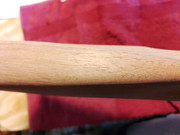
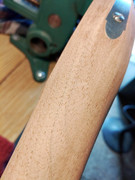

Perfect sheen!
Which of the Waterlox are you using? I have two different kinds.Yup normal walnut. I sand to 220-320, whiskering at each grit step. Damp rag followed by hair dryer. Then stain if you want. Wisker again as needed. Touch up stain. I normally flood on a heavy coat of Water lox finish. Keeping it wet for a good hour for deep penetration. Then allow it to get tacky. Scrub with a sock till all finish is either scrunched into the grain or rubbed off. Repeat daily for about 5-6 days. Flooding is not needed just normal coats. Still scrubbing with a sock when each coat is tacky. By then your grain should be filled. Relief carved guns probably should not be treated this way. The edges would definitely catch heck. I like to do my finishing with as many of the metal parts in place as I can before scrubbing, such as entry pipes and but plates. I’ll install these while the first coat is on the stock befor scrub down. BJH
Norman Brooks
45 Cal.
I'm sorry you disagree... dave_persons has the correct procedure for sealing walnut. Maybe you should follow his procedure,,,Sorry, I disagree.
He did get excellent results with his process, that I can't dispute, but which I found somewhat complex for a finishing beginner. There are a thousand ways to finish wood, and they all work, giving a thousand satisfactory, but different results, depending on the wood and what the woodworker wants. There is NO ONE "correct procedure" for any one wood or any one finishing application. It's more a kind of a going with what gives the results wanted and be willing to vary the process midstream when the results don't match the expectations. Wood is one material that's very forgiving of mistakes and starting over from scratch.I'm sorry you disagree... dave_persons has the correct procedure for sealing walnut. Maybe you should follow his procedure,,,
Thanks for your opinion, but I'll continue to disgree with viewpoints like yours - that there's only one correct way - in order to continue following my own inner lights and experiences, and learning from others, that guide me in future projects.
Last edited:
BJHabermehl
40 Cal
The one by minwax solvent based not water. I never heard of a second kind.Which of the Waterlox are you using? I have two different kinds.
Waterlox and minwax are two different companies products. Most people have never known of Waterlox.The one by minwax solvent based not water. I never heard of a second kind.
user 34300
54 Cal.
- Joined
- Nov 25, 2019
- Messages
- 1,742
- Reaction score
- 2,125
The Minwax I have used had virtually no solids. I would not use it on a gunstock.
There are tons of satisfactory products. I now use gloss spar varnish. I have no brand preference. Spar varnish, because it works and is easy to get. I dilute it with turpentine and add a dash of japan dryer. Apply it in very thin coats. I normally use pieces of lady's stocking material to apply because it has no lint. I store a small amount in a screw top tupperware. After adding the japan dryer it will last about a week.
There are tons of satisfactory products. I now use gloss spar varnish. I have no brand preference. Spar varnish, because it works and is easy to get. I dilute it with turpentine and add a dash of japan dryer. Apply it in very thin coats. I normally use pieces of lady's stocking material to apply because it has no lint. I store a small amount in a screw top tupperware. After adding the japan dryer it will last about a week.
Dave: Do you sand between coats of S-W tongue oil?Hi,
Walnut has open rays or pores that need to be filled. If you don't use a filler of some sort, it will take many coats of finish to fill the pores. Some like a dull in the wood oil finish with the pores mostly still open. That is not an authentic finish except for some later 19th century military guns and perhaps some really primitive and rustic American guns. On non military guns I make in walnut, I almost always fill the pores. I do so by applying finish (in my case Sutherland-Welles polymerized tung oil) with 220 sand paper and sanding the wood and finish until a slurry of sawdust and finish forms on the surface. I let that dry to a crust and then sand it smooth with 320 grit paper. Then I apply finish in thin coats that are let to sit for 10-15 minutes and then completely wiped off. I apply the coats until I get the sheen I desire. Here are walnut stocked guns finished that way.
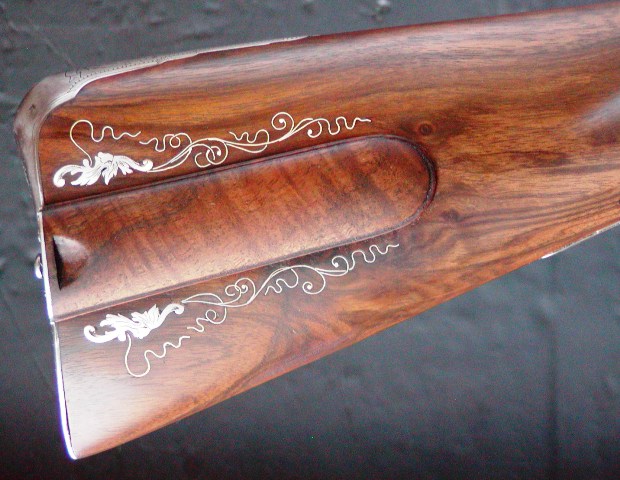
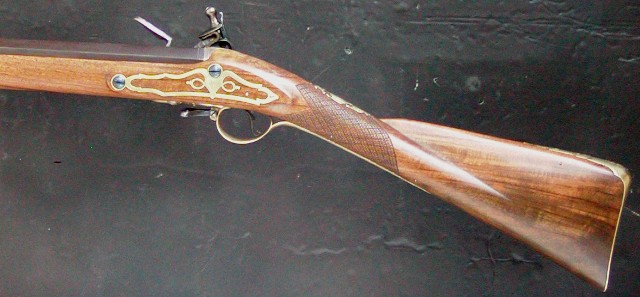

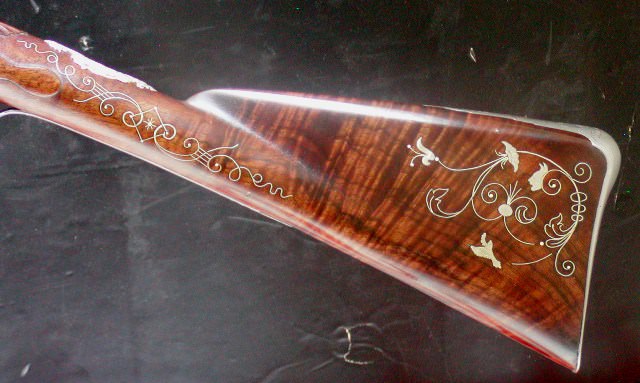
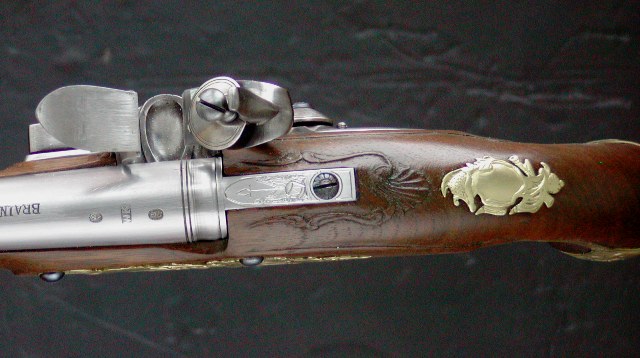
dave
- Joined
- Nov 26, 2005
- Messages
- 5,259
- Reaction score
- 11,098
Hi,Dave: Do you sand between coats of S-W tongue oil?
After sanding the initial slurry off smooth, I do not sand between coats. There is no need but you must apply the finish, let sit for a few minutes and then wipe off the excess completely. You want thin coats.
dave
- Joined
- Sep 10, 2021
- Messages
- 190
- Reaction score
- 184
I’m reworking a Pedersoli walnut stock at present, and using Tried & True to finish. I got a pint of it to use for a Kibler kit. Could work on walnut and I had some free time so…figured, why knot (there’s two wood puns for you).
Ron hall
32 Cal
what dave saidHi,
Walnut has open rays or pores that need to be filled. If you don't use a filler of some sort, it will take many coats of finish to fill the pores. Some like a dull in the wood oil finish with the pores mostly still open. That is not an authentic finish except for some later 19th century military guns and perhaps some really primitive and rustic American guns. On non military guns I make in walnut, I almost always fill the pores. I do so by applying finish (in my case Sutherland-Welles polymerized tung oil) with 220 sand paper and sanding the wood and finish until a slurry of sawdust and finish forms on the surface. I let that dry to a crust and then sand it smooth with 320 grit paper. Then I apply finish in thin coats that are let to sit for 10-15 minutes and then completely wiped off. I apply the coats until I get the sheen I desire. Here are walnut stocked guns finished that way.





dave
- Joined
- Oct 6, 2020
- Messages
- 1,715
- Reaction score
- 2,896
I have 4 sample pieces of walnut I'm finishing currently to see which one I like best. I have decided I'm leaving the grain open. I like the way it looks. And besides if I don't like the finish I settle on, down the road I can redo it. Here's a list of what I'm trying.
1 - Straight BLO 5 coats, finished with paste wax
2- Minwax Antique oil finish
3- Homemade finish 1/3 Helmsman Spar Urethane, 1/3 BLO, 1/3 Mineral Spirits
4- Sam Maloof Recipe 1/3 Tung oil, 1/3 BLO, 1/3 Beezwax.
1 - Straight BLO 5 coats, finished with paste wax
2- Minwax Antique oil finish
3- Homemade finish 1/3 Helmsman Spar Urethane, 1/3 BLO, 1/3 Mineral Spirits
4- Sam Maloof Recipe 1/3 Tung oil, 1/3 BLO, 1/3 Beezwax.
TDM
Cannon
- Joined
- May 28, 2022
- Messages
- 9,664
- Reaction score
- 24,245
- Location
- Louisiana & My camp in Mississippi
If it's possible to use a 5th test piece I highly recommend a BLO/gum turpentine mix. Maybe 5/1 or 6/1, I add whatever it takes to thin the BLO or T&T oil varnish, just a little at a time until it runs smoothly off the stir stick. You'll get better penetration, a smoother finish, and amazingly short dry times.I have 4 sample pieces of walnut I'm finishing currently to see which one I like best. I have decided I'm leaving the grain open. I like the way it looks. And besides if I don't like the finish I settle on, down the road I can redo it. Here's a list of what I'm trying.
1 - Straight BLO 5 coats, finished with paste wax
2- Minwax Antique oil finish
3- Homemade finish 1/3 Helmsman Spar Urethane, 1/3 BLO, 1/3 Mineral Spirits
4- Sam Maloof Recipe 1/3 Tung oil, 1/3 BLO, 1/3 Beezwax.
Oh yeah I'll try it, I have plenty of walnut to cut test pieces from. 5 or 6 parts BLO 1 part Turpentine.If it's possible to use a 5th test piece I highly recommend a BLO/gum turpentine mix. Maybe 5/1 or 6/1, I add whatever it takes to thin the BLO or T&T oil varnish, just a little at a time until it runs smoothly off the stir stick. You'll get better penetration, a smoother finish, and amazingly short dry times.
Yes. And can be done that way with tung oil to speed it up, too.If it's possible to use a 5th test piece I highly recommend a BLO/gum turpentine mix. Maybe 5/1 or 6/1, I add whatever it takes to thin the BLO or T&T oil varnish, just a little at a time until it runs smoothly off the stir stick. You'll get better penetration, a smoother finish, and amazingly short dry times.
Yesterday, t bought a quart of 100% Pure Tung oil. The young guy behind the counter was ADAMANT that I purchase the citrus thinner otherwise I wouldn't be able to use it on anything.
Oh, he just didn't know what the he** he was talking about.The young guy behind the counter was ADAMANT that I purchase the citrus thinner otherwise I wouldn't be able to use it on anything.
Similar threads
- Replies
- 25
- Views
- 1K
- Replies
- 6
- Views
- 474







